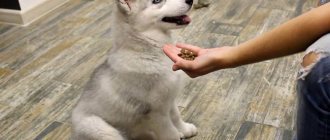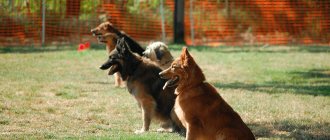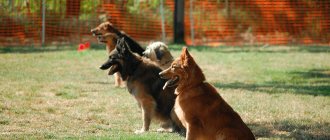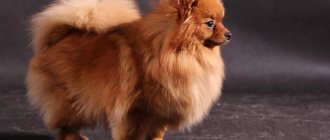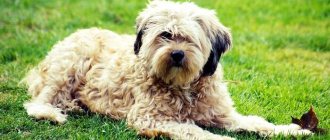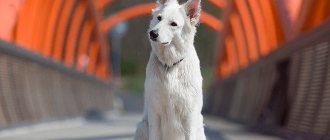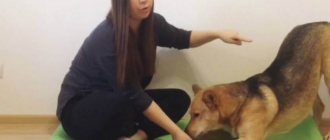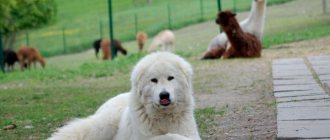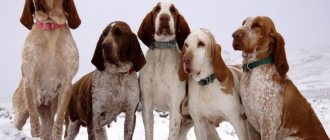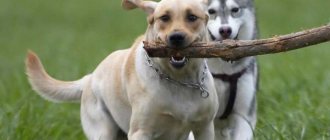Raising and training a dog is a very responsible activity. The pet's behavior depends entirely on how seriously its owner approaches training. Insufficient dedication of the owner to raising his pet will lead to the fact that the animal will not obey basic commands, which is extremely important for the dog. This is especially important for hunters, since during a hunt a dog is not just a pet, but also an active assistant in the task.
How to avoid risks when buying a puppy
Many breeds that were previously considered hunting breeds have now practically lost their working qualities. This happens when several generations are not used for their intended purpose. The hunting instinct becomes dulled and is not transmitted genetically - the dogs become unsuitable for hunting.
How to choose a hunting dog:
- Familiarize yourself with the register of hunting breeds.
- Choose a puppy from working parents (field diplomas are required).
- Decide in advance what kind of breed is needed (what type of hunting the beginner is going to do).
- An important factor is health. The entire litter, like the parents, must be healthy, otherwise you will have to forget about hunting.
- Do not have any illusions, do not buy a toy breed puppy in the hope of a productive hunt.
Puppies of hunting breeds bred for show class can also disappoint in the hunt. If 4 generations or more have not participated in the hunt, it is unlikely that it will be possible to awaken the instinct of a gambling hunter.
You can contact an experienced specialist who will help you choose parents, evaluate the entire litter, and tell you which puppy is the most promising. Congenital inclinations awaken at the age of 1.5 - 2 months.
When to start training a hunting dog
You need to raise and train a hunting breed dog immediately after it appears in the house. The first 7 months of a puppy’s life are called “the time of deep memory.” During this period, conditioned reflexes are developed as quickly as possible; the dog remembers the commands learned at this time for a long time.
The first days of a puppy in a new home
The first day after the puppy leaves the breeder is a lot of stress for the dog. To smooth out the puppy’s hysterical state a little, it is recommended to bring him to his new home in the morning. The baby's day will be full of new smells, people, surroundings, he will get used to the place a little, and will stop being afraid. This will exhaust the puppy, in the evening he will fall asleep soundly until the morning, and will not howl from boredom and fear at night.
A day after the move, you can begin the first training session - accustoming him to his nickname. The dog must know its own name and react to it in any situation. To do this, you need to associate the nickname with a positive - you cannot scold the pet by calling it by name. Communicating positively with the dog, treating it with treats, stroking it, establishes a connection between the owner and the pet, which will have a beneficial effect on training and obedience.
The main task of the owner at the initial stage is to teach the puppy to listen and understand the intonation of the voice and gestures. This is the only way to prepare for fishing will be successful.
Upbringing
Initial education begins at home, while the puppy is in quarantine. All classes should be conducted in a playful way; negative reinforcement is not recommended at this stage. The dog may become nervous and intimidated.
Training doesn't have to be boring for a young dog. No more than 15 minutes are allocated to practice the exercises. Classes are held 2 to 4 times a day, before meals. It is better to finish the training while the dog still wants to exercise, so the dog will not “burn out” and will look forward to each training session.
After complete immunization, veterinarians allow pets to be taken outside. When the puppy gets comfortable in the yard, you can begin preparing for hunting - introducing him to hunting grounds, forests, and marshy areas. Move obedience classes to unfamiliar places.
You cannot scold a puppy if it is frightened by noise, new smells of the street - it refuses to carry out a learned command. This will only aggravate the situation; until the animal is fully socialized, you should not demand strict execution of the order. Even well-trained dogs, in a stressful situation for them, may refuse to obey their owner.
The first days of a puppy in a new home
You brought the puppy home. It could just be a crossbred puppy without a pedigree given by a friend, or it could be a promising descendant of famous parents. The young dog generally “doesn’t care” who its parents are. The result depends only on the new owner - what kind of dog will turn out in a year - an adequate, obedient and trained assistant on the hunt and, at the same time, a pet, the best friend of children and the pride of the family. Or an angry, nervous dog, with whom there is no point in going hunting, since he will do what he wants, tear and eat trophies, disgrace the owner in front of other hunters. And indeed it is. There are so many examples when hunters even had to simply shoot titled dogs because they were completely uncontrollable.
Future hunters
Therefore, the very first and most important stage is raising a puppy. Moreover, training in obedience and all basic commands does not depend on the breed of the dog.
Moreover, even a puppy of a non-hunting breed can be trained to search for prey - the main thing is that the owner and the dog form a single whole. And this can be achieved and is not so difficult.
First of all, the puppy must be given his personal place. And not on the passage in the corridor, but in a semi-closed place where he can rest peacefully, but will still be “in touch” with his household. It is very unwise for those new owners of hunting puppies to set aside an enclosure or a kennel in the yard and forget about their pet until it grows up.
I'm already helping my owner on the hunt!
No bowl of food, even the most nutritious and elite, can replace a baby who has lost his mother and his family, live communication with the new owner.
You need to communicate with the puppy more, talk constantly, teach him your rules. Only this approach will give the desired result. That hunter who has raised his dog in all understandings of this word can hope that his pet will continue to understand him without words and during the hunt will do everything he can and will also show initiative for the benefit of the common cause.
Mentor and mentee
Basic command training
Regardless of whether the dog goes hunting or not, it should be comfortable in everyday life. In addition, many basic commands are also useful in fishing. After the puppy has learned its name and is accustomed to the necessary equipment, you can move on to learning basic commands.
Mandatory commands for each dog:
- to me;
- fu (impossible);
- near;
- place;
- fetch;
- sit, lie, stand.
For a working assistant to a fisherman, the following commands will also be useful:
- carry;
- give;
- quiet;
- take;
- voice;
- seek;
- left;
- right.
After practicing voice orders, you can start working on the same commands using gestures - this is a necessity for working dogs.
An experienced trainer can teach basic commands to a puppy for up to 5–6 months, subject to daily training. Some overly independent breeds require more time. Then the training moves to the next stage - polishing already learned orders with distracting factors.
You can’t focus only on teaching commands; in parallel with obedience classes, you need to:
- Take time for good socialization of the puppy - pets growing up in conditions of social deprivation grow up cowardly and unsure of themselves.
- It is also advisable to get used to shooting in advance.
- Practice endurance.
- Familiarize the dog with the hunting grounds and the areas in which it will work.
- Give good physical training, teach swimming.
- Go through the stage of passive training - familiarize the puppy with the smells of wild animals, teach them to fetch chicken paws or wings of game.
If by 6 months the owner of a hunting dog has a strong feeling that his dog does not want to go hunting - he does not sniff the tracks, does not react to game. Before going out into real fishing, the owner should work on the dog with redoubled effort, encouraging even the most insignificant successes. Or contact an experienced trainer who will help awaken the getter instinct.
When training puppies up to one year old, of any breed, modern animal psychology does not recommend the use of corrective equipment.
Snakes
When encountering a snake, the dog usually tries to grab it. At the same time, pets often get bitten. Therefore, you need to have antihistamines with you. These are first aid remedies for snake venom. Then the dog must be urgently taken to the veterinary clinic. The specialist will inject the animal with a special serum.
Under no circumstances should you hit the snake or try to drive it away. Otherwise, she may switch her aggression from the dog to the person. And snake bites are much more dangerous for people than for animals. Dogs have a higher resistance to viper venom.
Hunting team training
Upon reaching 6-8 months, when the puppy has fully mastered the base of commands and has undergone socialization, you can proceed to exercises on hunting commands. For beginners, in order to fully understand how to teach a puppy to hunt, it is recommended to seek help from specialists. Hunting dog breeding kennel clubs will recommend the nearest trainer-instructor in the region.
An experienced trainer will tell you how to help awaken the natural instinct of a canine hunter in your pet.
Whistle
An important step is getting used to the whistle. It is most rational to use special ultrasonic whistles that are inaudible to others.
Teaching your dog to come when you hear a whistle is very simple:
- the command “come to me” is given;
- followed by a whistle signal;
- obligatory praise after completion.
You cannot call the puppy to punish him, otherwise the dog will be afraid to approach the owner.
The whistle can be used for any order, for example:
- one signal – “come to me”;
- two signals – “stop” or “left”;
- three signals - “lie down” or “right”.
Then everything depends on the desire, experience, and imagination of the hunter.
Importation
“Give” or “Fetch” is one of the most difficult, but at the same time necessary commands for a working dog. It is necessary to learn to fetch objects from childhood, repeating the exercises every day, gradually making it more difficult.
Classes begin at home with a fun game:
- Take a toy, tease the puppy with it, attract attention.
- Toss aside.
- An interested puppy will run after the toy.
- When the baby grabs the fetch, you need to call him.
The following options may be available:
- The puppy sniffed the toy without grabbing it in his teeth and ran to the call - you need to repeat the exercise from the beginning, spend more time exciting the pet, flirting and teasing before giving up fetch.
- He grabbed the object in his teeth and ran in the other direction, inviting him to play catch - in this case, you need to start running away from the dog, in the opposite direction from him. 99% of puppies will run after their owner.
- He took the fetch in his mouth and came with it to the call - the most desirable outcome of the action, then all that remains is to “exchange” the toy for a treat. Afterwards – practicing the reflex and polishing the “correctness” of execution.
- The puppy was frightened by a toy or the owner’s call, ignored a thrown object, ran away or hid - the most undesirable outcome, which cannot be avoided without the help of a specialist.
When the dog understands what is required of him, it is necessary to gradually move on to complications. Start using a dummy game as a retrieval item, throwing the socks into the water or tall grass.
Search in the grounds
To prepare a dog for searching in areas, it is very convenient if the dog knows the commands “left” and “right” - by voice, gesture or whistle, it doesn’t matter. The wider the dog’s search area, the better for the hunter – the more productive the hunt.
To train for a wide search, you need a suitable area - most often swampy, approximately 150 - 200 meters in size. The dog is allowed to search with the command “search”. Next, they correct with the orders “left” - “right” when the dog reaches the edge of the area intended for search.
It is very important to conduct training in different directions of the wind, otherwise the dog will not search, but follow the scent. Which will certainly affect the amount of production.
Game work
When the future assistant fisher has learned how to properly search the land, he can begin working on game. The dog is brought to areas where there are birds.
To set up the work correctly, it is more convenient to conduct the first meetings with game on a leash. The steps are as follows:
- the dog is allowed to search, the hunter moves nearby with a leash in his hands;
- as soon as the dog smells the game (the pointer slows down, the spaniel waves its tail excitedly), the hunter must get as close as possible to the dog without interfering with its work;
- the dog stands in a stance - the hunter gives the command “forward”;
- when the bird has risen, the dog must be restrained so that it does not rush after the game without a command.
It is more advisable if 2 people participate in the first game training. One walks with a leash and keeps the dog from breaking the stand, lays the bird down after takeoff, the second shoots. A broken stand can affect the amount of game caught, while premature escape after the game while being shot can affect the health of the dog (especially dangerous during group hunting).
Ticks
Ticks pose a significant danger during forest walks. They are carriers of serious diseases - tick-borne encephalitis and borreliosis. Therefore, 2-3 days before a walk or hunt, it is useful to use drops or aerosol against forest parasites. You can put a special anti-tick collar on your pet.
However, such remedies do not always protect against bites. Therefore, after each exit into the forest, you need to carefully inspect the wool. If you find a tick, you should not try to remove it yourself. It is better to seek help from a veterinary clinic.
Features of training different breeds
Each hunting breed has its own working purpose and training characteristics. For pointers and spaniels this is training, for greyhounds and huskies, for burrows - training, for hounds - training. The main task of specialized training is to teach hunting skills, develop and improve the working qualities of the dog.
Before starting a special training course, it is necessary to study the law on baiting. At the moment, there is a prohibited bill on cruel methods of training hunting dogs.
Greyhound baiting
The main working qualities for greyhounds:
- agility;
- vigilance;
- greed for the beast;
- agility when driving.
In a dog with good genetics, from working ancestors, these qualities are innate, but they can be developed with the help of training.
The main prey of greyhounds are brown hares and foxes; baiting is done with the same animals (or with the help of coursing). For young greyhounds, experienced dogs can be used as teachers. Or point the greyhound at the decoy hare yourself, encouraging with exclamations and gestures so that the dog picks it up and chases it. If a young dog is afraid of an animal previously unknown to him, he needs to return to the stage of education and socialization, and resume baiting later.
Training of huskies
Laikas begin to be baited only after learning the basic course. Representatives of Spitz-types are not only the most versatile hunters, but also the most stubborn and independent. Therefore, until the commands have been worked out to the point of automaticity - come to me, you can’t, give me - you shouldn’t start baiting (usually by 7-8 months the puppy is ready for work).
Laika, although considered a universal hunter, cannot work equally well on both ducks and bears. Dogs of this breed are trained using different methods, depending on the type of fishing in which the owner is engaged. The most popular method of baiting huskies is imitation (with the help of an experienced dog).
Racing the hounds
They begin to train hounds from 8 to 10 months, when the dog has already learned the main commands (for hounds, the minimum set is - come to me (or come to the horn), next to me, give me). The procedure of searching for a trace and driving the animal is a fun game for the dog and does not cause any problems. It is more difficult to teach her not to wander off the path, i.e. quickly find the trail lost after a hare discount.
A big mistake of many hunters in areas where there are a lot of hare is that they themselves remove the dog from the cliff, switching to another hare path. Thus, preventing the development of viscosity in the hound. To get the hound back on the trail, the hunter needs to approach the spot where the hound has been chipped, encouraging the dog with exclamations of “look,” and walk in widening circles trying to scare off the hare.
Baiting of burrowing dogs
Noble dogs are formed in their bones and psyche earlier than large breeds, which is why training with them begins earlier. If by 6 months the pet knows and clearly performs the basic obedience with voice and gestures, you can begin training.
To begin with, you can use rats in cages, let the dog bark and “attack the twig box.” Then the cage is covered with a dark cloth and the dog is allowed to strangle the prey.
Then they move to an artificial hole and bait the fox. First, the dog is accustomed directly to the hole, taught to fetch objects from it (scars wrapped in skin or stuffed prey). Then, at the end of the improvised hole, the fox is driven and the grate is lowered. Then they set the dog on a fresh fox track, encouraging them with exclamations of “take it.”
When baiting rats and wild animals, we must not forget about vaccinations. Since wild animals can be carriers of rabies, leptospirosis and other viral infections and protozoan parasites.
Training of cops
After mastering the basic commands and searching the grounds, the cops are taught to give a diarrhea (both on land and from the water). Feeding game directly is taught only when the dog is accustomed to remaining motionless after the bird takes off and is shot.
You can train a pointer using free-range or decoy game. It is recommended to start training from the age of 7 – 8 months.
Spaniel training
Spaniels are especially popular among game hunters due to their training abilities, small size and excellent sense of smell.
Training spaniels is identical to training the hunting skills of cops. When training, it is necessary to pay special attention to holding, fetching (including from the water) and moving with a wide shuttle.
Retrievers
The historical task of the retriever was to retrieve game from the water. In the Middle Ages, pointers were considered an “elite” breed and they were not supposed to do the “dirty” work of bringing in game. The hunt went like this:
- The cop searched and lifted the bird onto its wing.
- After the shot, the retriever looked for game and retrieved it from the water or bushes.
But the excellent sense of smell combined with the ability to train retrievers has proven over time that they can search for and pick up a bird just as well as cops. Training a retriever is identical to training pointers and spaniels.
At the moment, it is almost impossible to find a good working line of this breed. Retrievers began to be seen more and more often at exhibitions, and less and less often in hunting grounds.
Hunting dog tests
Testing the working qualities of hunting dogs and the degree of preparation for hunting (tests) is carried out in natural conditions on a free or decoy animal (bird).
The tests are based on established standards for groups of hunting dog breeds and approved rules. Each state has its own rules, depending on the established legislation. The standards are the same, regardless of the region.
Dogs that successfully complete the tests (60 points and above) receive diplomas of I, II, and III degrees. Dogs that have reached the age of 8 months, but not older than 10 years, are allowed to be checked.
Test periods for each group of breeds are established in the inspection rules for various types of game.
Raising a good assistant for the fishery is not an easy task. But the time spent on training will be only a small price to pay for valuable trophies.
Survival
These days, many people are keen on survival in difficult conditions. They make multi-day trips with overnight stays in the forest. In this way they train their skills necessary in an extreme situation. Is it worth taking animals on such a difficult hike? Is it possible to survive with dogs in the forest?
Experienced survivalists believe that a dog can be very useful on such trips. However, not every dog is suitable for being in extreme conditions. For a pet to become your survival companion, it must have the following qualities:
- be large and strong enough;
- have excellent health;
- have developed guard qualities;
- be able to hunt game;
- be able to obtain their own food.
- have high intelligence.
If you are going to go out into the forest with a dog, then such qualities must be cultivated in the puppy from childhood. The following dog breeds are best suited for survival in wild forest conditions:
- likes;
- malamutes;
- alabai;
- husky;
- Jagdterriers;
- Fox Terriers.
These breeds are quite intelligent and hardy. When surviving in extreme conditions, a dog can be of great help to a person. A dog trained since childhood will become a good guard and hunting companion when going into the forest.
